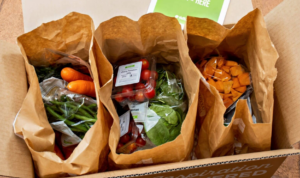A recognizable trend in the Western world is the growing spending on pets. American Bark is, by its own admission, the most “dog-centered” company in the world. In a short time, it has grown from a dog-loving business to a thriving business enterprise with an established customer base.
In 2020, Bark was listed on the New York Stock Exchange, but its share price has fallen by over 80% since then. Underlying, the company is performing well. Passionate management expects to break even at the ebitda level this year. That should be achievable because free cash flows have been positive for two quarters.

Hugo
Hugo was a large 65-pound Great Dane who lived in the heart of New York City. Because his owner, Matt Meeker, found few amenities for a dog of that size, he started looking for suitable accessories. Thus was born the idea of putting together packages for dogs of different sizes that dog owners could order online. In the first month, Meeker shipped 94 packages, which prompted him to start a business. Before then, Meeker had started another Internet company, Meetup, which was eventually sold to WeWork for $200 million.
Barkbox was founded in 2011 by Carly Strife, Henrik Werdelin and Matt Meeker as a subscription service that delivers a monthly box of toys, chews and other dog accessories. From the beginning, 10% of the proceeds went to shelters for neglected dogs. When Barkbox had nearly 500,000 subscribers in 2016, August Capital and Resolute Ventures climbed on board with a $60 million private equity financing. Moments later, the aforementioned dog Hugo became ill and Meeker resigned his position as top executive to care for him. The new ceo, Manish Joneja, took the company public in December 2020 by merging with Spac Northern Star. The IPO, which saw the name changed to Bark, raised $454 million, giving the company an enterprise value of $1.6 billion. A year later, the company called on Meeker again, as cash outflows had been running high in the meantime under Joneja. In January 2022, Meeker replaced him, and he is still ceo.
Financial results
The previous ceo had become a little too optimistic because of the momentum generated by covid. In a short time, the workforce grew by 25% and he stockpiled high levels of inventory as a precaution. When demand fell short of expectations, losses quickly mounted. Inflation created additional problems because Bark never increases subscription fees for existing subscribers on principle. For example, some customers who have been continuous subscribers since 2012 still pay the then current rate of $17.
So when Matt Meeker took over as top executive again in 2022, he immediately took steps to stem the cash drain. He laid off 12% of the workforce, renegotiated contracts with suppliers and delivery drivers, and for new customers he introduced shipping costs of $4.99, while the subscription price went to $35 a month.
The effect of the clean-up is readily apparent in the results statement. Annual expenses decreased by $12 million, bringing operating income to a loss of $63 million, significantly better than the $94 million loss in fiscal year 2021/2022.
The strong growth of recent years leveled off when Meeker raised the subscription price. Customers had to pay an average of $32.07, which still increased revenue by 5.5%, but reduced the number of subscriptions marginally for the first time.

Current products and services
The Barkbox is still by far the most important product. The classic Barkbox contains two toys, two dog snacks and an object to chew, and these days the box usually comes with a theme. The 2.2 million Barkbox subscriptions bring in between $22 and $35 each month and provide predictable revenue that accounts for 75% of the group’s revenue.
The market potential is great and Bark is buzzing with energy. The development team, BarkBeta, receives a budget of one percent of sales and develops 600 new ideas a year. The most important new product line is Bark Super Chewer, a subscription service aimed specifically at large dogs and dogs that need to chew a lot. 2019 saw the launch of Bark Home, a product line featuring everyday accessories such as dog beds, collars and chains. Bark Bright focuses on animal welfare and provides dental care products, among others. Of all the new initiatives, management has the highest hopes for Bark Eats, the product line that delivers measured food packages tailored to breed, age and size of dog.
Market Approach
The fact that people in the Western world generally have fewer and fewer children is fueling increasing pet ownership. Covid also gave a big boost to pet ownership so that America now has 63 million dog owners who collectively spend $70 billion a year.
Bark has switched to the omnichannel concept. Customers can not only order the individual items online through the Bark store, but also buy them at Home Depot, Target, Costco, Petco and Amazon. Traditional retailers contribute 10% of group sales.
To strengthen brand perception, Bark undertakes numerous initiatives. BarkPost, the weblog with videos, attracts 10 million visitors monthly and is sponsored by American Express, Procter & Gamble and Subaru. Barklive organizes a variety of events for dogs and their owners. BarkCare is a 24-hour hotline for consulting veterinarians and BarkAir provides vacations with dogs. Not all of these services are a financial success, by the way, but they do increase brand awareness.
Recent quarterly results & forecast
By the fourth quarter (March 2023), the net loss had been reduced to $14.2 million, which was significantly better than the $36.7 million a year earlier. Adjusted ebitda came in at $3.4 million negative, which was also much better than the $23 million negative a year earlier. Operating cash flow was now $19.2 million positive, although that is partly explained by a 20% drop in inventory levels. After deducting capital expenditures, $16.7 million of free cash flow remained, so Bark has now generated positive free cash flows for two quarters in a row. This was necessary, by the way, because in fiscal year 2021/2022, cash of $194 million still flowed out of the company.
Last March there was $177 million in cash on the balance sheet, $13.7 million more than in the previous quarter, although this is offset by $81 million in debt. Without question, the balance sheet is solid.
For the current quarter, management expects virtually unchanged revenue of $122 million and adjusted ebitda of $10 million positive. For the entire 2023/2024 fiscal year, sales will decline by up to 5%, but ebitda will turn positive and next year could be black under the line.
Rating & Conclusion
At its IPO in late 2020, Bark had a market capitalization of $1.6 billion. Barely $250 million of that remains, while revenue is 35% higher, survival is not in jeopardy, and the company is steadily heading toward profitability. For valuation, it is best to use revenue multiples. Enterprise value is only 40% of revenue, which is low anyway. Chewy (CHWY) and Petshop (WOOD) are similar companies that are slightly more mature and larger. They list at EV/Sales multiples of 1.59x and 0.89x, respectively, despite the fact that their stock prices have also fallen sharply. For a growth company like Bark, which is cash flow positive and has a strong balance sheet, an EV/Sales multiple of 1x seems conservative. Converted, that would correspond to a share price of about $3.
The company’s founders apparently feel the same way. All three still work at Bark, and together they own nearly 20% of the shares. Of the founders, Matt Meeker is the smallest shareholder with 9.8 million shares, but he did buy the most in the past year. Perhaps needless to say, we remind investors that young small caps are above-average risk, so investors would do well to keep their positions limited.
The author and coauthor hold positions in Bark.
Key data
Ticker: Bark
Isin Code: US68622E1047
Stock Market: NYSE
52-week highest price: $2.74
52-week highest price: $1
Latest price:$1.37
Number of shares: 178 million
Stock market value: $237 million
Enterprise value: $193 million
Revenue: $535 million
EV/Sales: 0.38
Price/ tangible book value: 1.35x



